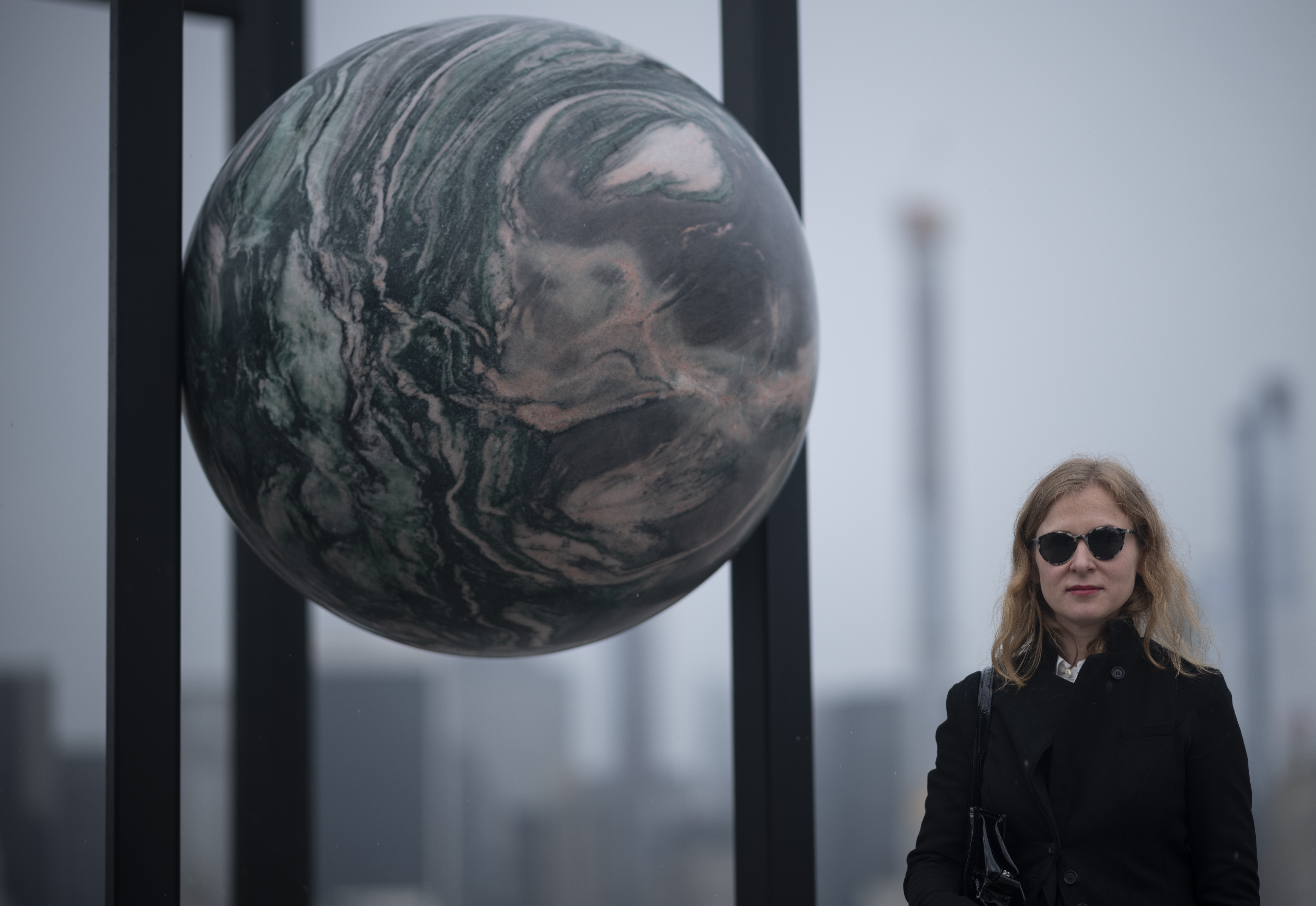
The artist Alicja Kwade’s newest project—a 15-foot-tall illusionistic sculpture installed atop the Metropolitan Museum of Art—is about metaphysics. It’s also meta—and very physical.
ParaPivot, which opens today, is the latest Roof Garden Commission at the museum, following last year’s installation by Huma Bhabha and a project by Adrián Villar Rojas the year before that. Rendered in the Polish-German artist’s signature post-Minimalist language, the two-part sculpture evokes an Astrolabe—an ancient Greek instrument used to project the planet’s orbital pathways. Aesthetically, it looks like a cross between a Whee-Lo toy and a science fair diorama of the solar system.
Nine marbled spheres—some of which weigh more than a ton—sit suspended among a series of interlocking steel frames. The spheres give off an uneasy feeling, appearing to be both frozen in a gravity-defying moment, and capable of falling on you at any moment. (They won’t: the sculpture was inspected and approved by city officials for public presentation.) Like the nine planets they symbolize, the stones each have a different look, composition, and backstory. One is made of azul macaubas sourced from Brazil; another comes from materials found in Norway.
“It’s crazy, when you think about it—these stones spheres are compressed time,” Kwade told artnet News at a preview for exhibition. As she spoke, she looked out past her sculptures, with Central Park and the buildings that lurch above it reflected in her black sunglasses. Overhead, the sky went grey as clouds rolled in. “They are millions and millions of years old,” she said of the stones.
Alicja Kwade poses next to ParaPivot atop the Metropolitan Museum of Art. Photo: Johannes Eisele/AFP/Getty Images.
Kwade, now 40, seems to be just as in awe of this fact as she was when she first learned it. It’s not hard to imagine similar moments of cosmic clarity informing all of the artist’s works. That’s one reason her work consistently resonates with curators—and why it’s particularly suited for public display. Her sculptures, heady though they can be, are also informed by a simple sense of worldly wonder.
“Kwade’s works begin with a moment of disbelief,” said Kelly Baum, the curator of the show. “So she’s out in the world, trying to understand or believe the origins of the universe or the molecular composition of a human body or mass-capitalism. It’s that moment when she realizes, ‘Wait a minute, this is strange and absurd; I don’t get it.’ That’s when she starts making work.”
Alicja Kwade’s work on the roof terrace of the Metropolitan Museum of Art. Photo: Christina Horsten/Picture Alliance/Getty Images.
When the museum first approached Kwade with the commission opportunity, they wanted to present one of her mirrored sculptures, something akin to WeltenLinie, which was installed at the 2017 Venice Biennale. But in the end, Kwade eschewed actual mirrors for this show, despite the fact that the motif has occurred throughout much of her work, in favor of a more conceptual interpretation of mirroring.
ParaPivot isn’t kinetic per se, but it gives off the illusion of movement. You’ll likely find yourself walking around it to compensate. And as you do so, you’ll see that—just as the work is framed by the jagged New York skyline behind it—the work’s own steel frames the skyscrapers as well. This isn’t an accident. The installation puts you in the center of the universe while also making you realize your insignificance in the grand, cosmic sense of history.
“We’re all playing this game,” Kwade said. “Everyday things seem so important. But then you zoom out and realize that you’re standing with another 7 billion [people] on a spinning sphere.” With that perspective, she says, you’re reminded to just be glad you’re here at all.
Alicja Kwade speaks at the Metropolitan Museum of Art in New York. Photo: Christina Horsten/Picture Alliance/Getty Images.
But with skyscrapers towering in the background, the installation also serves as a reminder of perhaps more mundane, less infinite truths.
“These skyscrapers are symbols of capitalism,” the artist says, gesturing to the buildings at the park’s edge and the people who live in them. “These peoples are like gods on this planet. So I tried to put planets on top of them. I meant it be ironic, skeptical. I mean, when buildings like that are being built and priced the way they are, at an invented rate—that is [expletive] funny.”
A few minutes later, in a moment that felt oddly fitting, the sky opened up and it began pouring rain. Kwade, posing for pictures, just laughed.
Rain falling atop ParaPivot by Berlin-based artist Alicja Kwade atop the Metropolitan Museum of Art on April 15, 2019. Photo: Johannes Eisele/AFP/Getty Images.
“Alicja Kwade: ParaPivot” is on view through October 27, 2019 at the Metropolitan Museum of Art. A new exhibition of Kwade’s sculptural installations, “Alicja Kwade: ParaParticular,” is on view at 303 Gallery through May 18, 2019.